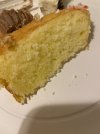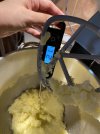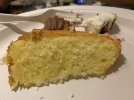Hi there,
Been binge reading the posts in the cake forum and mustering up courage to ask for help to troubleshoot my bundt cakes.
Background
I used this recipe: https://www.kingarthurbaking.com/recipes/lemon-bliss-cake-recipe
I made glaze but not icing.
Made it as is for 10cup bundt. Then halved it to fit the 4cup capacity.
Ingredients were weighed.
Baked at 350F for 25 mins. Oven pre-heated and using a thermometer. Oven is a small capacity (38qt) stand alone oven.
Unfortunately, I only have a hand held mixer. I think that impacts the consistency of the creaming and mixing in...
The 4 changes made to the original recipe was:
Personally, I like the taste of these cakes, but I would really love to make better cakes as I've been asked to sell them for Christmas.
What I can improve on
From reading the threads, I'll make the following change:





Been binge reading the posts in the cake forum and mustering up courage to ask for help to troubleshoot my bundt cakes.
Background
I used this recipe: https://www.kingarthurbaking.com/recipes/lemon-bliss-cake-recipe
I made glaze but not icing.
Made it as is for 10cup bundt. Then halved it to fit the 4cup capacity.
Ingredients were weighed.
Baked at 350F for 25 mins. Oven pre-heated and using a thermometer. Oven is a small capacity (38qt) stand alone oven.
Unfortunately, I only have a hand held mixer. I think that impacts the consistency of the creaming and mixing in...
The 4 changes made to the original recipe was:
- Swapping AP flour for cake flour (cake flour is bleached and chlorinated. 7.5g)
- Swap milk for full fat plain unsweetened yogurt (to reduce the perceived sweetness, the people eating/buying the cakes tend to dislike sweet tasting stuff, but they still want their cake! haha...)
- Replacing the zest of x1 lemon/1/8 tsp lemon oil with 1.5 tsp of lemon extract
- Removing 1.5tsp of yogurt to compensate for the additional liquid of the extract
- 113g unsalted butter, at room temperature
- 200g granulated sugar
- 1/2 teaspoon salt
- 2 large eggs, at room temperature
- 1 teaspoons baking powder
- 180g cake flour
- 113g yogurt
- 1.5 tsp lemon extract
- first time in 10 cup capacity bundt, using milk not yogurt. Followed the recipes instructions exactly. I like the crust of the milk version. Nice bite to crust, but cake tasted slightly dry.
- second - fourth time, in 10 cup & 4 cup capacity bundt. Using frozen pans. No more doming problem! But crust became soft...
Personally, I like the taste of these cakes, but I would really love to make better cakes as I've been asked to sell them for Christmas.
What I can improve on
From reading the threads, I'll make the following change:
- bake at 325F instead. Check at 25 mins.
- make sure my butter is straight from fridge (thanks for @Norcalbaker59 for these tips)
- add flour in twice and liquid in once, instead of thrice and twice to lessen the mix in time since I am using cake flour
- beat egg before adding in to reduce mixing time
- let glaze cool down before glazing
- I prefer the soft texture of the yogurt cake. But I had a bitey browner crust when I used milk instead of yogurt. How can I get the brown crust again, while still using yogurt?
- Should I aim to have less bubbles in my crumb? How many times am I suppose to bang my uncooked batter in pan to get rid of the air bubbles?
- What is the best way to fill the bundt pan? I spooned the batter onto the bottom, then spin the 10cup pan to force the batter to move up the sides of the pan. For the cakelet, I used a teaspoon to press the batter to the sides. Should I pipe the batter?
- I let the cake rest in pan for 5-10 mins after removing from oven before inverting them. Is this correct?
- How soon should I glaze the cakes?
- And should I try to use up every bit of glaze, or save half to re-glaze the second day? Or just glaze one coating?
- Re: the brown specks in the cake. I'm using granulated cane sugar. Why is my sugar granules so prominent? What can I do about it
- Appreciate any other advice!




